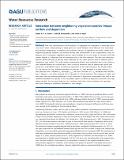| dc.contributor.author | Meire, Dieter W. S. A. | |
| dc.contributor.author | Kondziolka, John M. | |
| dc.contributor.author | Nepf, Heidi | |
| dc.date.accessioned | 2014-09-19T13:30:09Z | |
| dc.date.available | 2014-09-19T13:30:09Z | |
| dc.date.issued | 2014-05 | |
| dc.date.submitted | 2013-11 | |
| dc.identifier.issn | 00431397 | |
| dc.identifier.uri | http://hdl.handle.net/1721.1/89830 | |
| dc.description.abstract | Flow and sedimentation around patches of vegetation are important to landscape evolution, and a better understanding of these processes would facilitate more effective river restoration and wetlands engineering. In wetlands and channels, patches of vegetation are rarely isolated and neighboring patches influence one another during their development. In this experimental study, an adjacent pair of emergent vegetation patches were modeled by circular arrays of cylinders with their centers aligned in a direction that was perpendicular to the flow direction. The flow and deposition patterns behind the pair of patches were measured for two stem densities and for different patch separations (gap widths). The wake pattern immediately behind each individual patch was similar to that observed behind an isolated patch, with a velocity minimum directly behind each patch that produced a well-defined region of enhanced deposition in line with the patch. For all gap widths (Δ), the velocity on the centerline between the patches (U[subscript c]) was elevated to a peak velocity U[subscript max] that persisted over a distance L[subscript j]. Although U[subscript max] was not a function of Δ, L[subscript j] decreased with decreasing Δ. Beyond L[subscript j], the wakes merged and U[subscript c] decayed to a local minimum. The merging of wakes and associated velocity minimum produced a local maximum in deposition downstream from and on the centerline between the patches. If this secondary region of enhanced deposition promotes new vegetation growth, the increased drag on the centerline could slow velocity between the upstream patch pair, leading to conditions favorable to their merger. | en_US |
| dc.description.sponsorship | National Science Foundation (U.S.) (Grant OCE 0751358) | en_US |
| dc.description.sponsorship | National Science Foundation (U.S.) (Grant EAR 0738352) | en_US |
| dc.language.iso | en_US | |
| dc.publisher | American Geophysical Union (Wiley platform) | en_US |
| dc.relation.isversionof | http://dx.doi.org/10.1002/2013WR015070 | en_US |
| dc.rights | Article is made available in accordance with the publisher's policy and may be subject to US copyright law. Please refer to the publisher's site for terms of use. | en_US |
| dc.source | MIT web domain | en_US |
| dc.title | Interaction between neighboring vegetation patches: Impact on flow and deposition | en_US |
| dc.type | Article | en_US |
| dc.identifier.citation | Meire, Dieter W. S. A., John M. Kondziolka, and Heidi M. Nepf. “Interaction Between Neighboring Vegetation Patches: Impact on Flow and Deposition.” Water Resources Research 50, no. 5 (May 2014): 3809–3825. © 2014 American Geophysical Union | en_US |
| dc.contributor.department | Massachusetts Institute of Technology. Department of Civil and Environmental Engineering | en_US |
| dc.contributor.mitauthor | Kondziolka, John M. | en_US |
| dc.contributor.mitauthor | Nepf, Heidi | en_US |
| dc.relation.journal | Water Resources Research | en_US |
| dc.eprint.version | Final published version | en_US |
| dc.type.uri | http://purl.org/eprint/type/JournalArticle | en_US |
| eprint.status | http://purl.org/eprint/status/PeerReviewed | en_US |
| dspace.orderedauthors | Meire, Dieter W. S. A.; Kondziolka, John M.; Nepf, Heidi M. | en_US |
| mit.license | PUBLISHER_POLICY | en_US |
| mit.metadata.status | Complete | |
